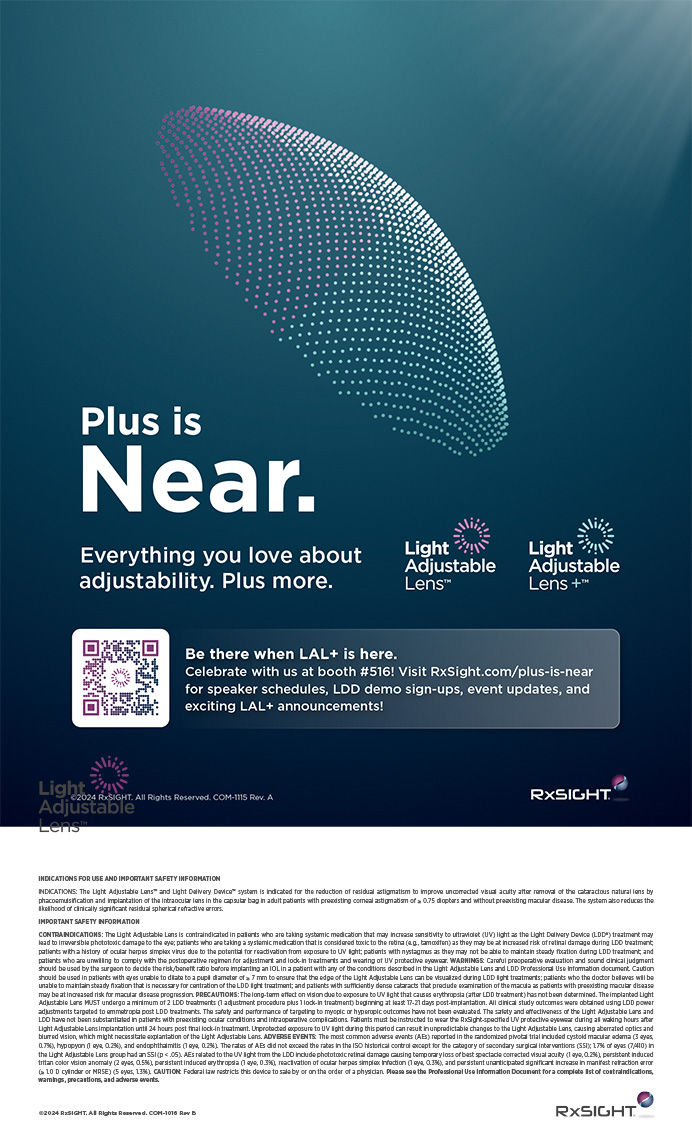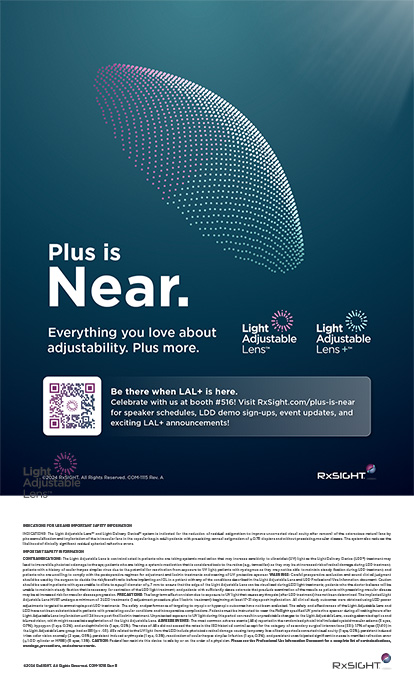I will perform optical coherence tomography on all patients who are considering a premium lens implant for their cataract surgery. My identification of any macular pathology whatsoever will limit the options I offer. I do not believe that someone who has retinal disease is an optimal candidate for a multifocal IOL, but I have no problem recommending a toric or an accommodating lens.
With an accommodating lens such as the Crystalens (Bausch + Lomb), all of the light rays are directed onto the macula, so I have had success using this technology in patients with macular pathology. Patients will obtain the intermediate range of vision with this lens. I make sure to explain to them that they will not achieve outcomes as good as those of patients without retinal disease.
I also inform patients that, if they have an epiretinal membrane, for example, and even if the changes are very mild, I prefer to use an accommodating IOL rather than a multifocal IOL. Often, patients presenting for cataract surgery will have had no retinal symptoms, so they are hearing this information for the first time.
The key to success and happy patients with any of the premium lenses is ensuring that these individuals have realistic expectations. I talk to them about the quality of their vision, and I keep the discussion very simple.
WHAT THE DATA SAY
In the past, ophthalmologists were unsure whether or not cataract surgery were safe in patients with age-related macular degeneration (AMD). In the past few years, however, many studies have been published that provide the answer to that question. Although the clinical signs of AMD at the time of cataract surgery have often been associated with longitudinally worse visual outcomes, a study in the Journal of Cataract and Refractive Surgery revealed that most patients with AMD had better corrected distance visual acuity (CDVA) 10 years following their cataract surgery than preoperatively.1
In the study, investigators examined 810 patients who were undergoing cataract surgery. The patients were evaluated over the course of 1 year. Clinical eye examinations and CDVA measurements were performed preand postoperatively and then again at 5 and 10 years postoperatively. The investigators found that more than 75% of patients with AMD had a better CDVA 10 years after the cataract surgery than before the procedure.
Another multicenter study from the National Eye Institute found that AMD patients benefited from cataract surgery.2 The procedure improved the visual acuity of patients with any stage—from mild to advanced—of AMD. According to the authors, this was the first study to include an adequate number of patients with advanced AMD. Data were obtained from the prospective Age- Related Eye Disease Study (AREDS), which was conducted to evaluate the effects of high-dose vitamin and mineral supplements on the development of cataracts and AMD.
The cohort included 1,939 eyes (1,244 patients) with various stages of AMD that were evaluated for visual acuity after cataract surgery. On average, patients with AMD gained visual acuity after cataract surgery; the best gains were in patients with a visual acuity worse than 20/40 before surgery. The authors wrote that no difference in improvement was noted between patients with neovascular or central geographic atrophy AMD. About 1 year later, gains in visual acuity remained statistically significant in the 865 eyes available for follow-up.
CONCLUSION
It is clear that cataract surgery can have many benefits for people who are suffering from age-related vision problems, including those who have AMD. Educating patients and helping them to have realistic expectations are vital to their satisfaction after surgery.
Cary M. Silverman, MD, MBA, a LASIK and refractive cataract eye surgeon, is the medical director of EyeCare 20/20 in East Hanover, New Jersey. He is a paid speaker for Alcon Laboratories, Inc., but acknowledged no financial interest in the products or companies mentioned herein. Dr. Silverman may be reached at csilverman@eyecare2020.com or via Twitter @The LASIKdoc.
- Mönestam E, Lundqvist B. Long-term visual outcome after cataract surgery: comparison of healthy eyes and eyes with age-related macular degeneration. J Cataract Refract Surg. 2012;38(3):409-414.
- Forooghian A, Agrón E, Clemons TE, et al. Visual acuity outcomes after cataract surgery in patients with age-related macular degeneration: Age-Related Eye Disease Study Report No. 27. Ophthalmology. 2009;116(11):2093-2100.


